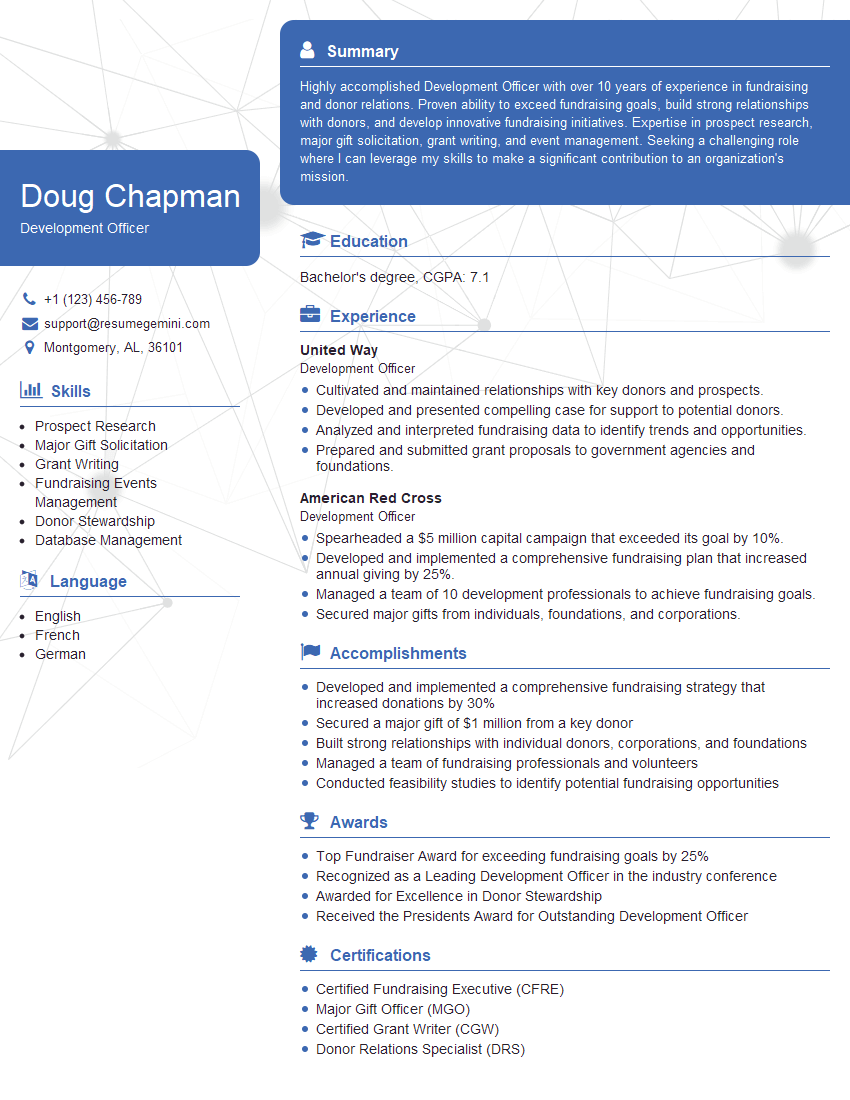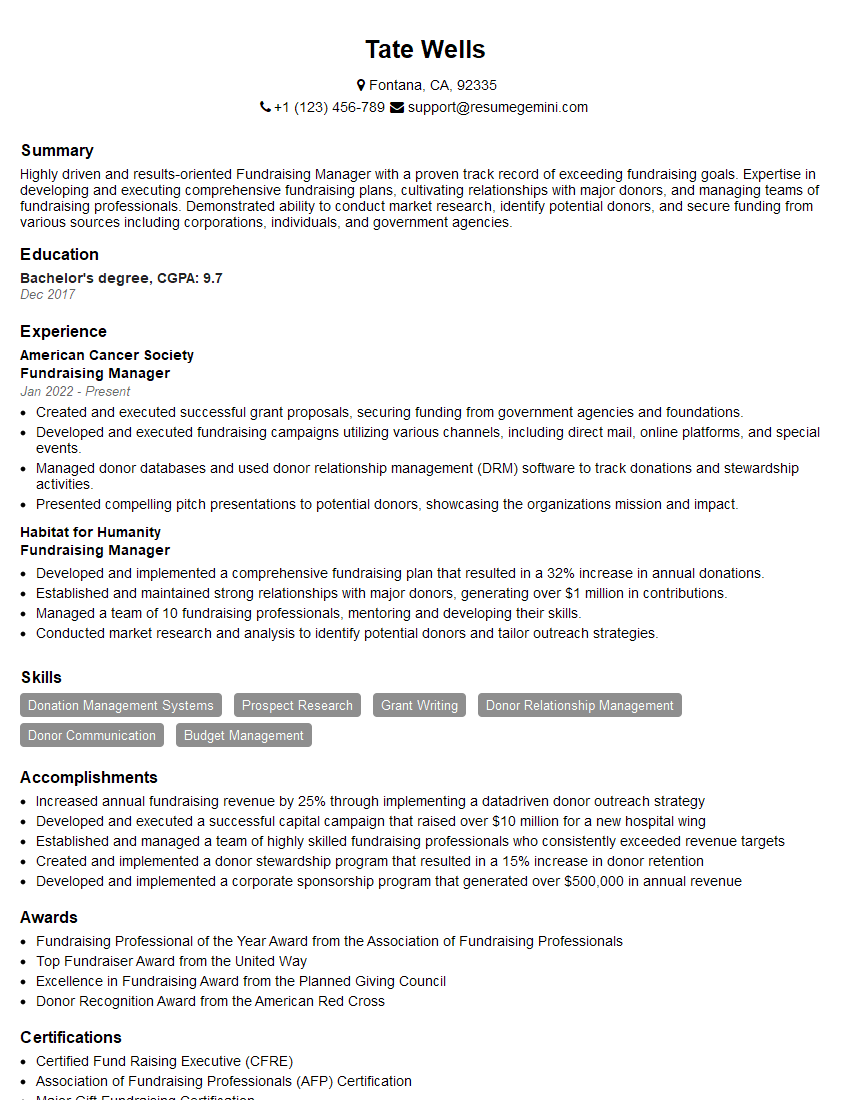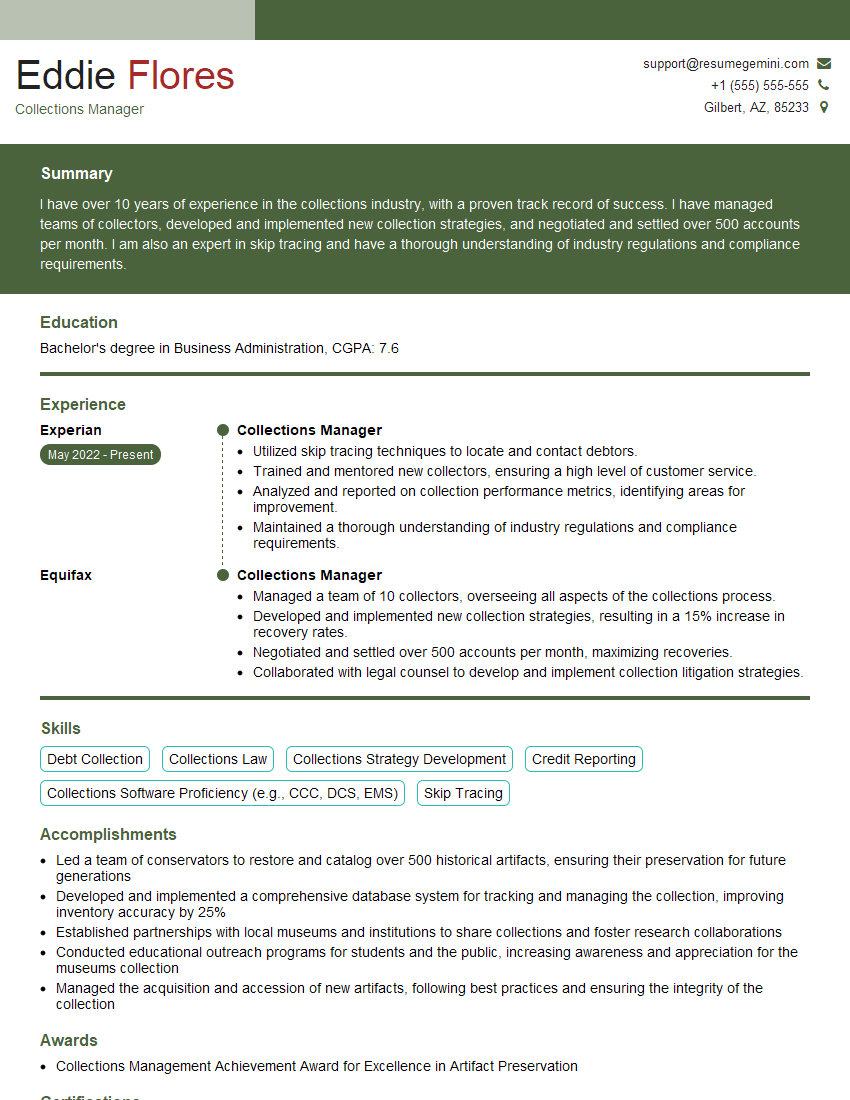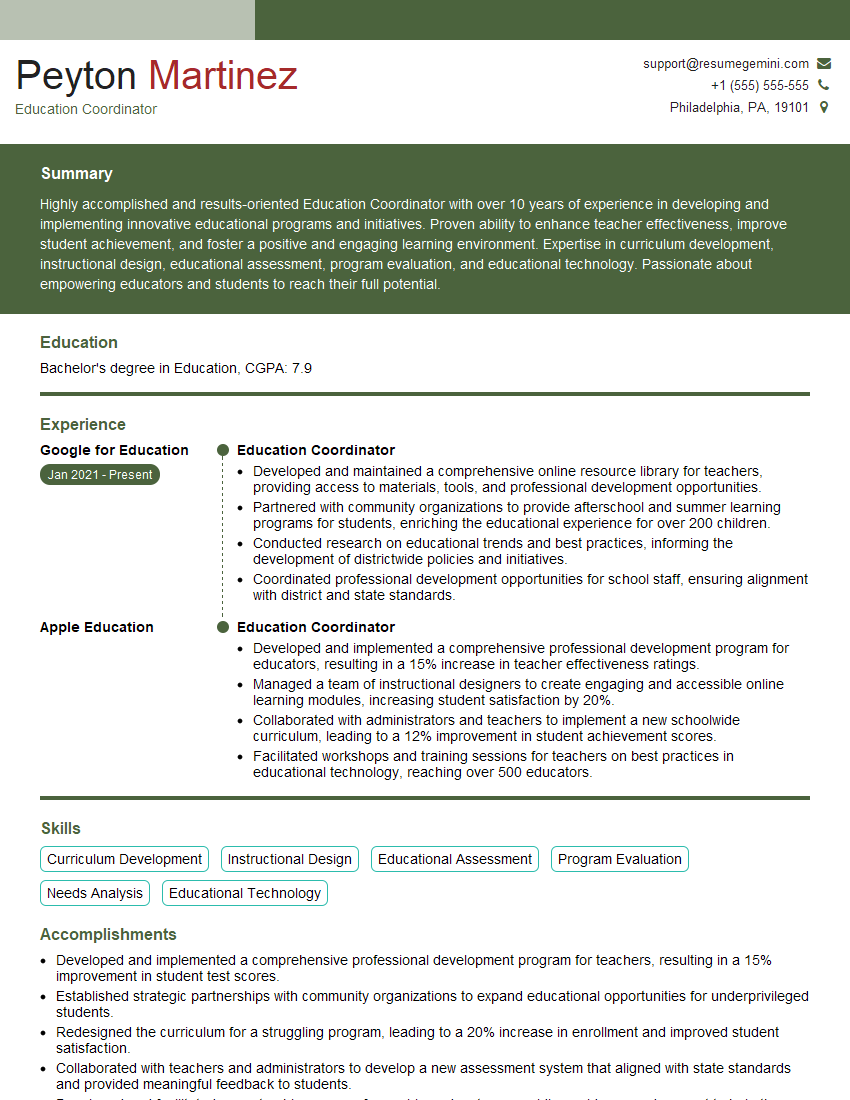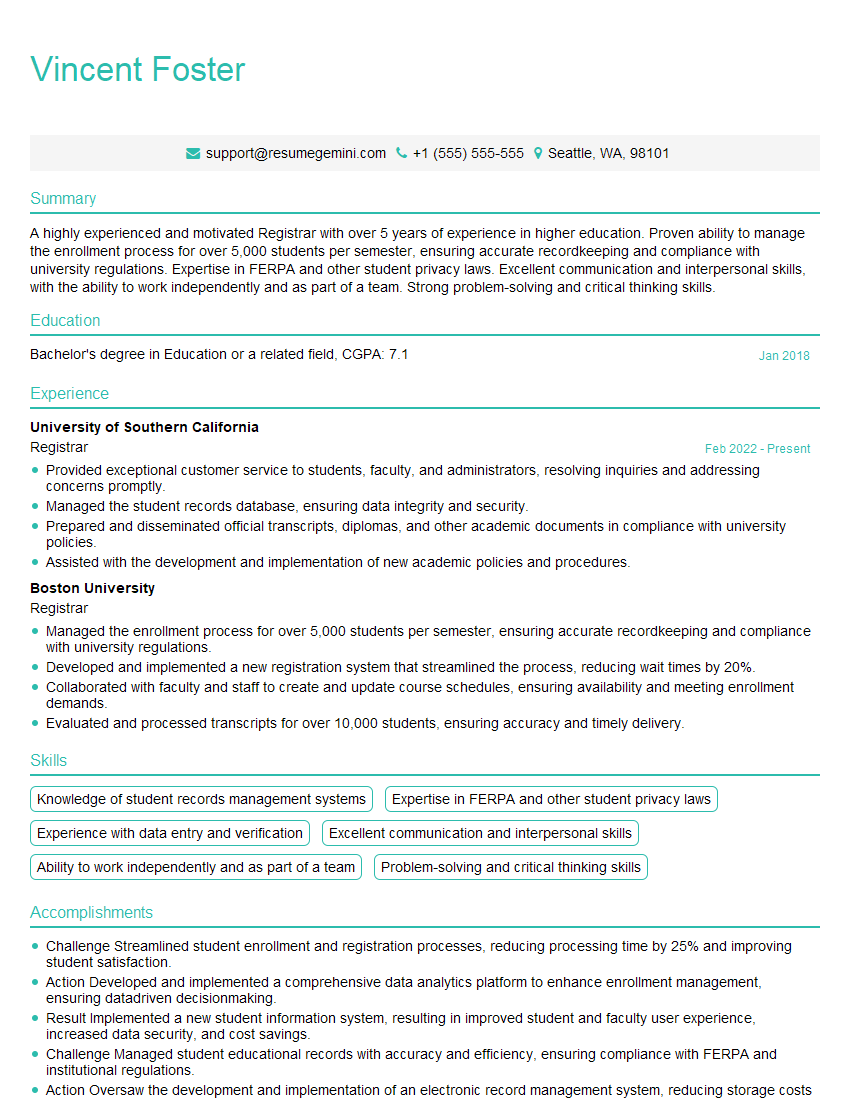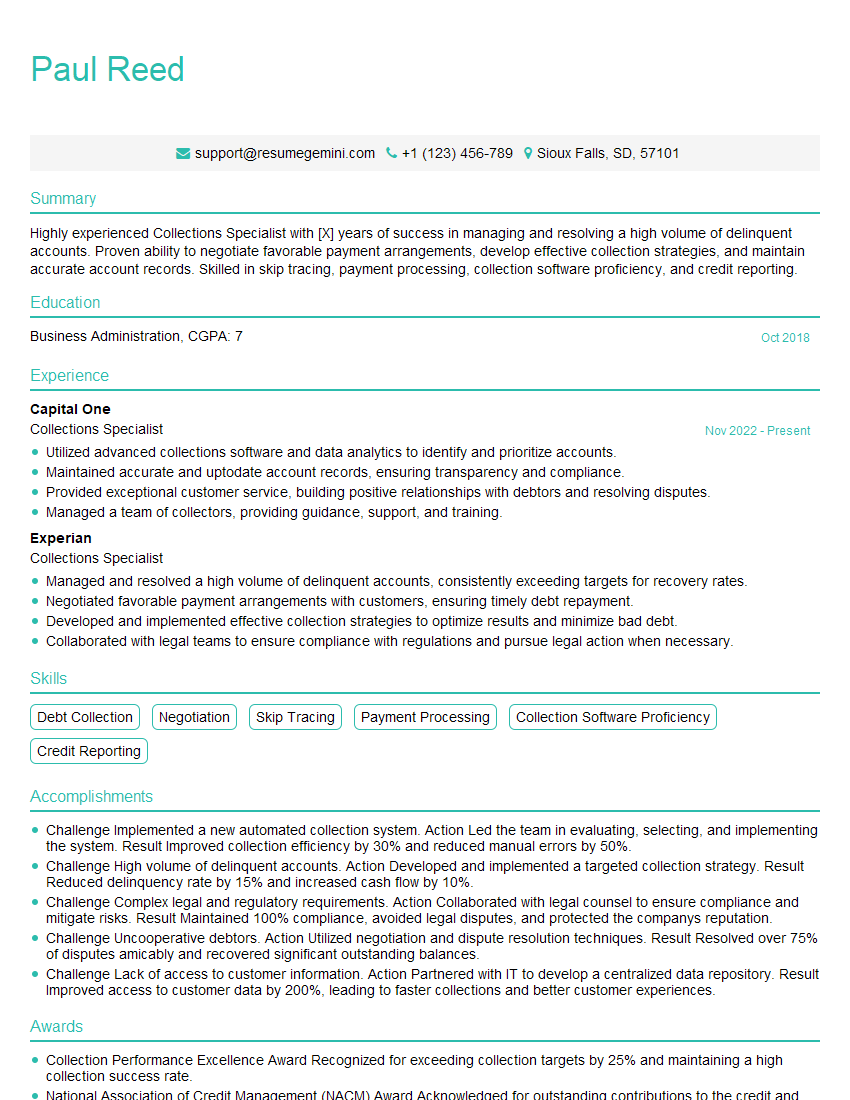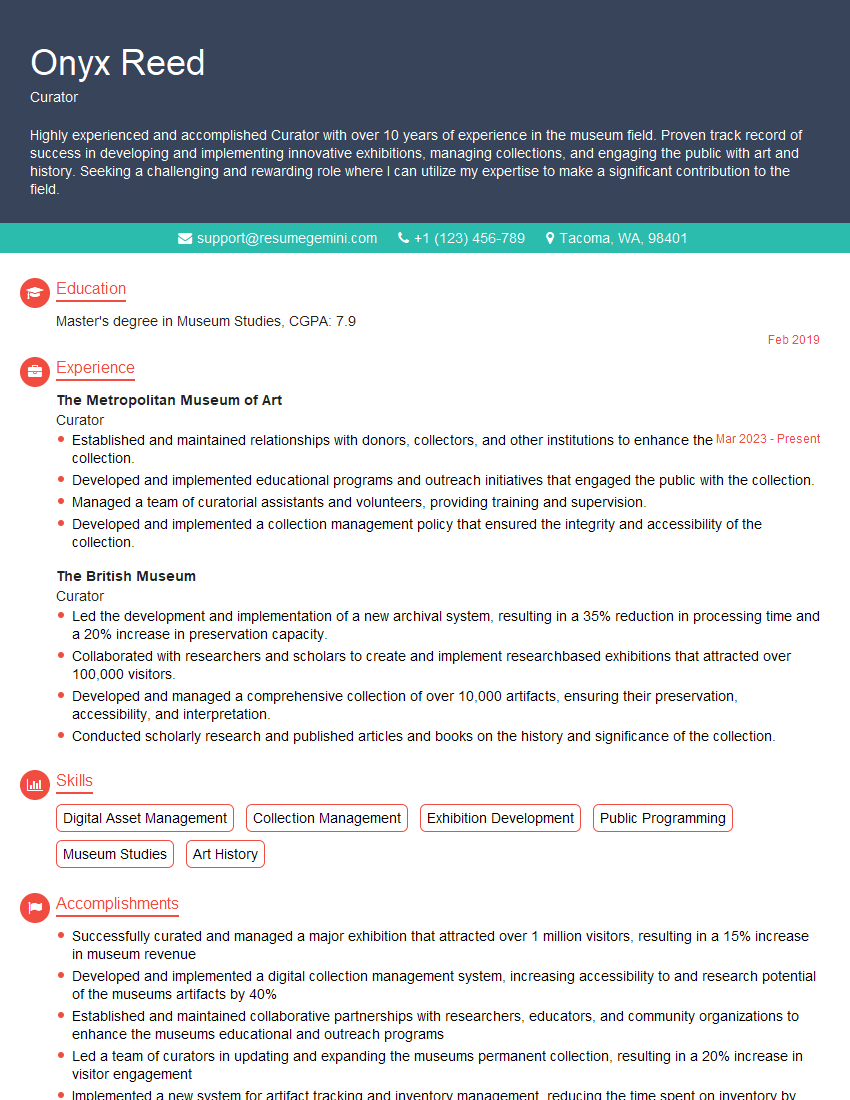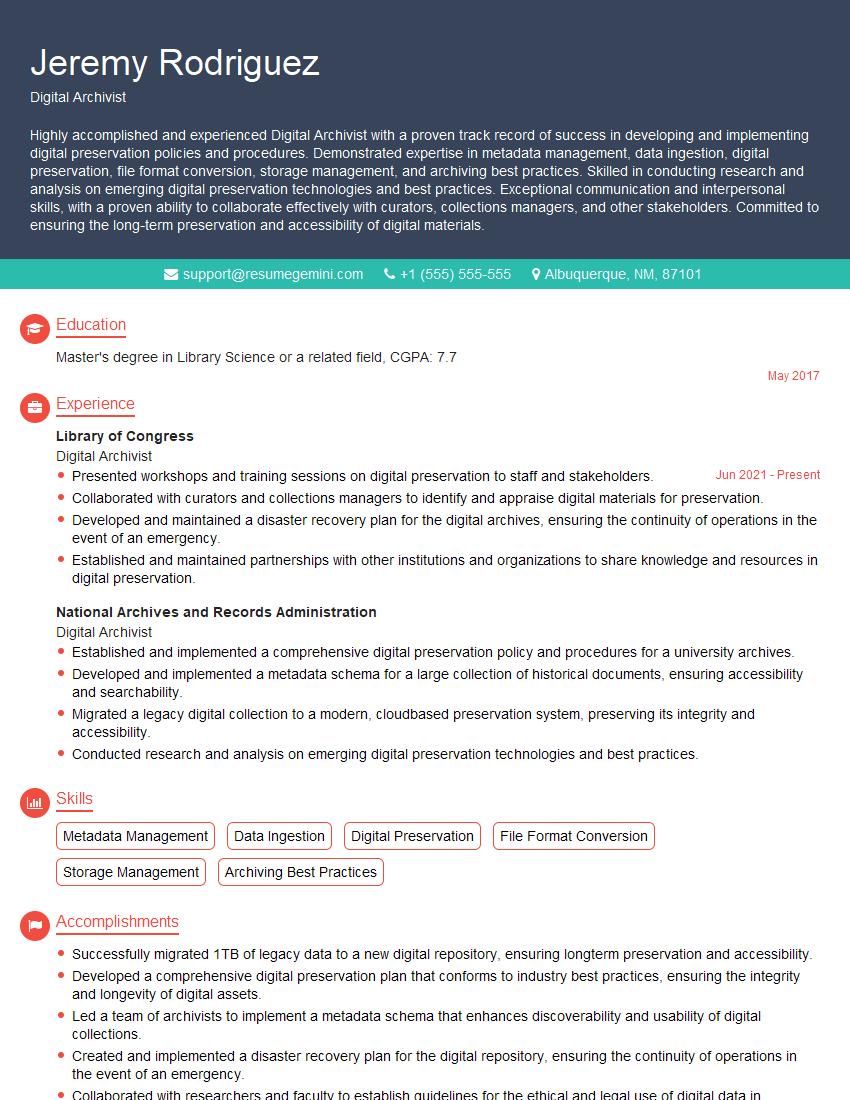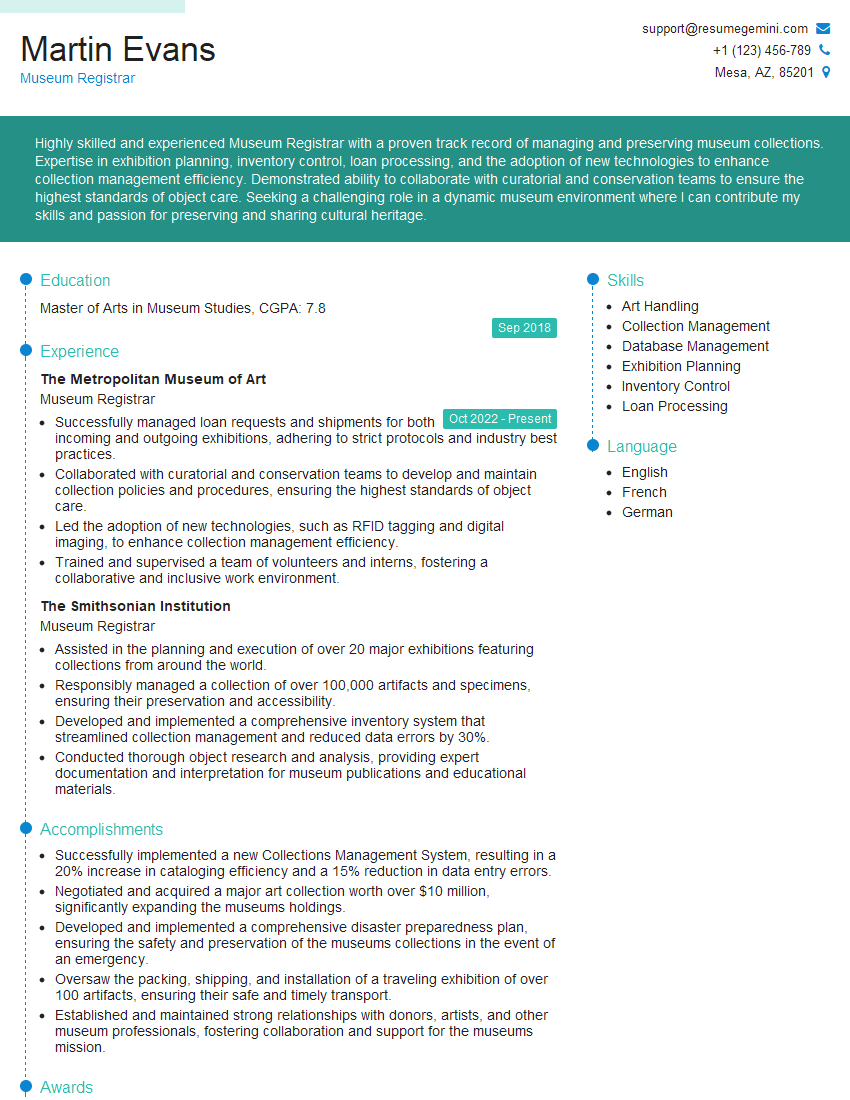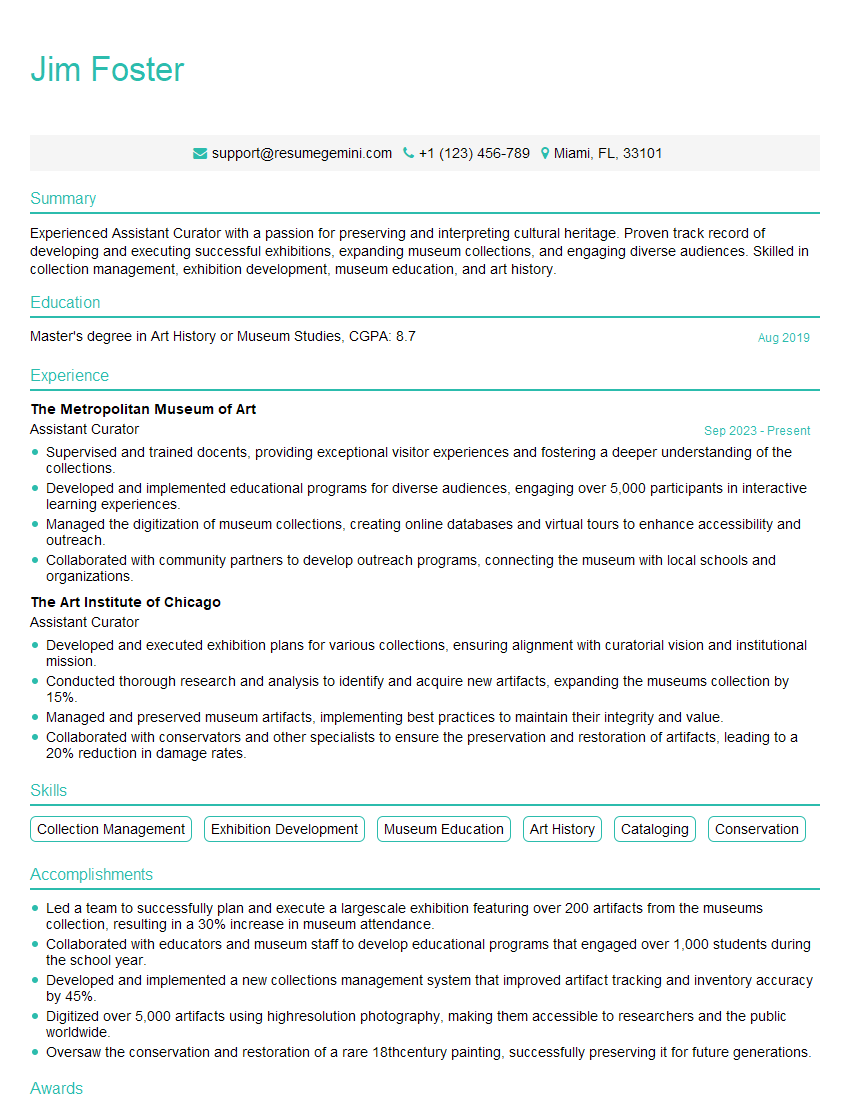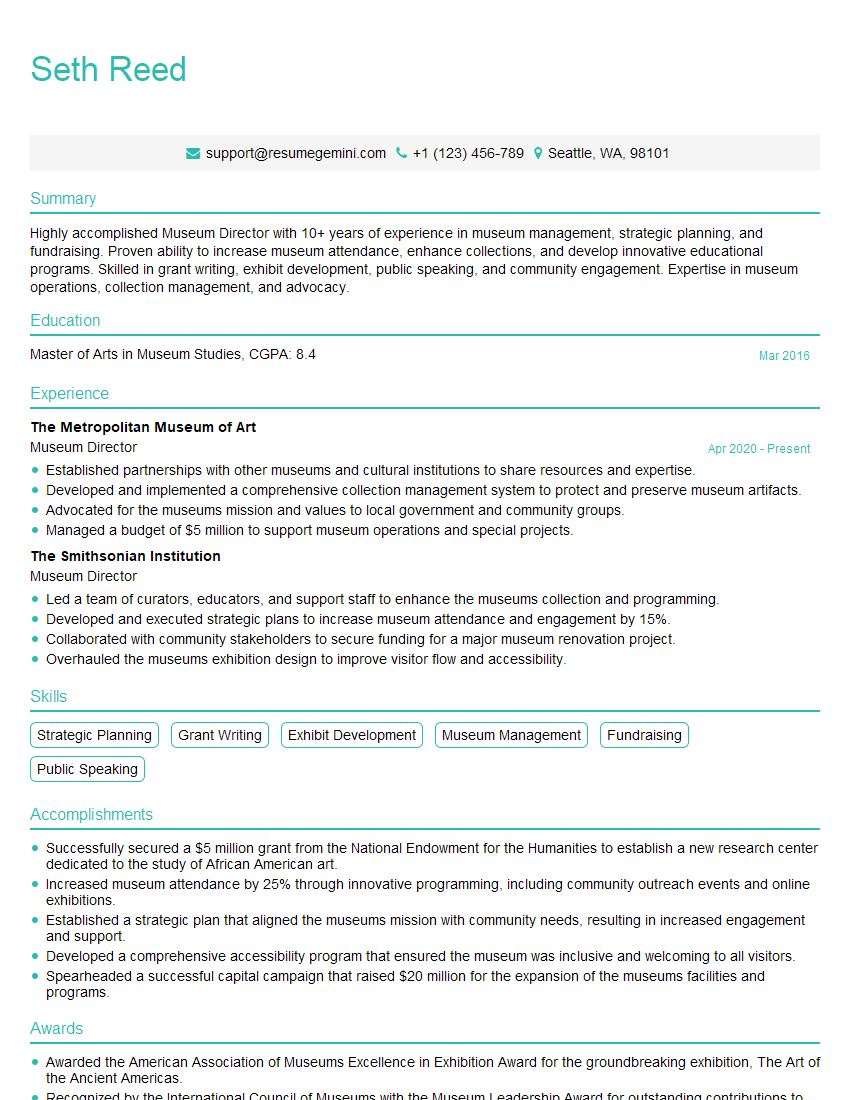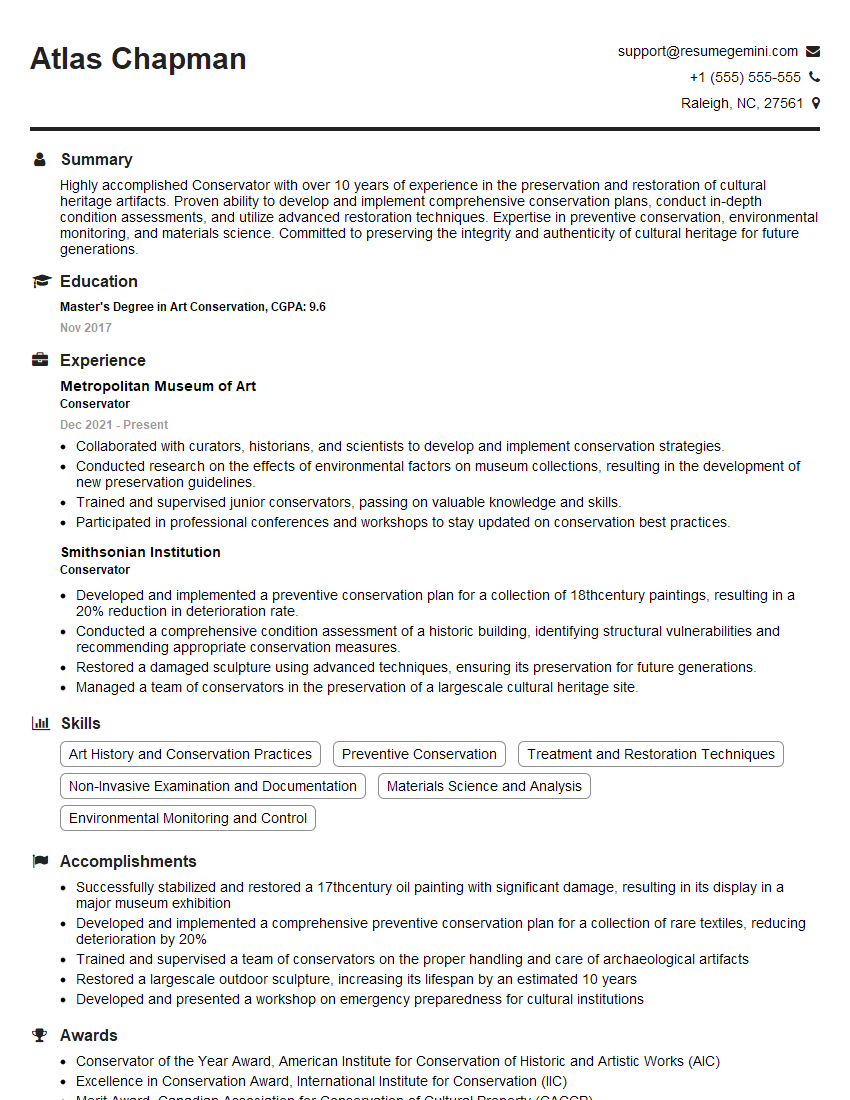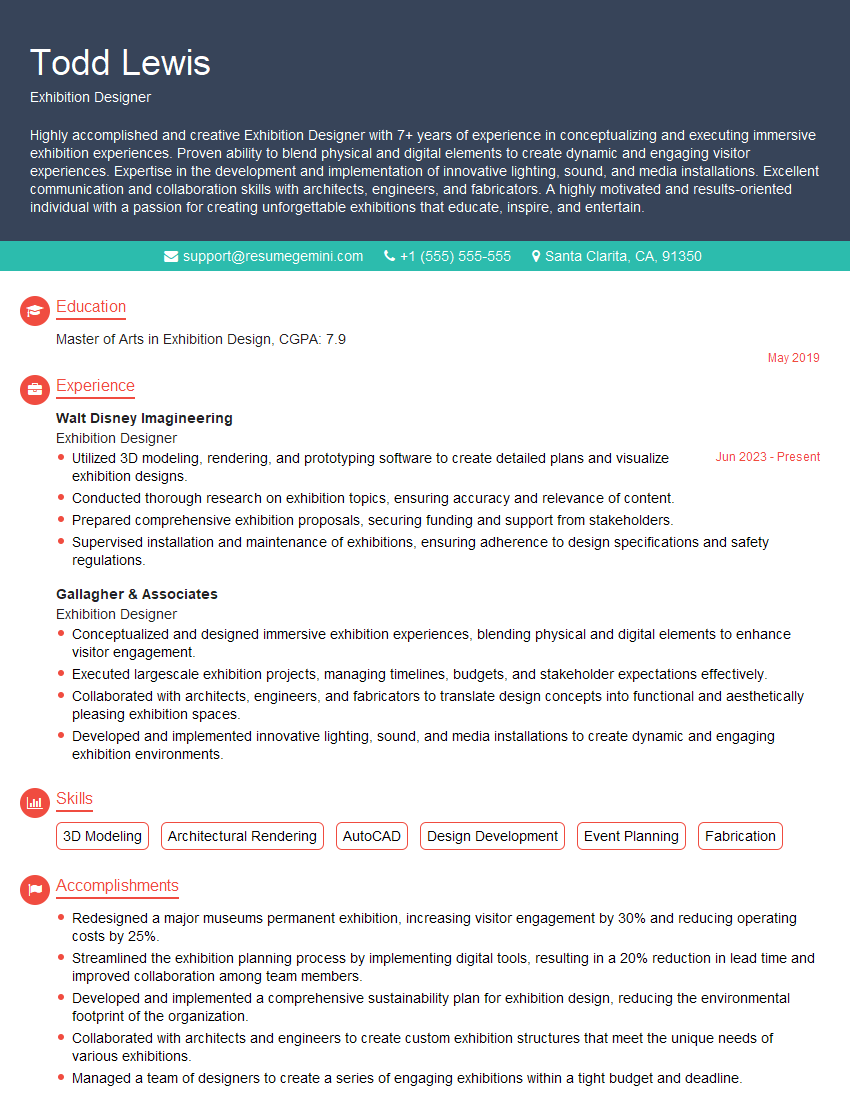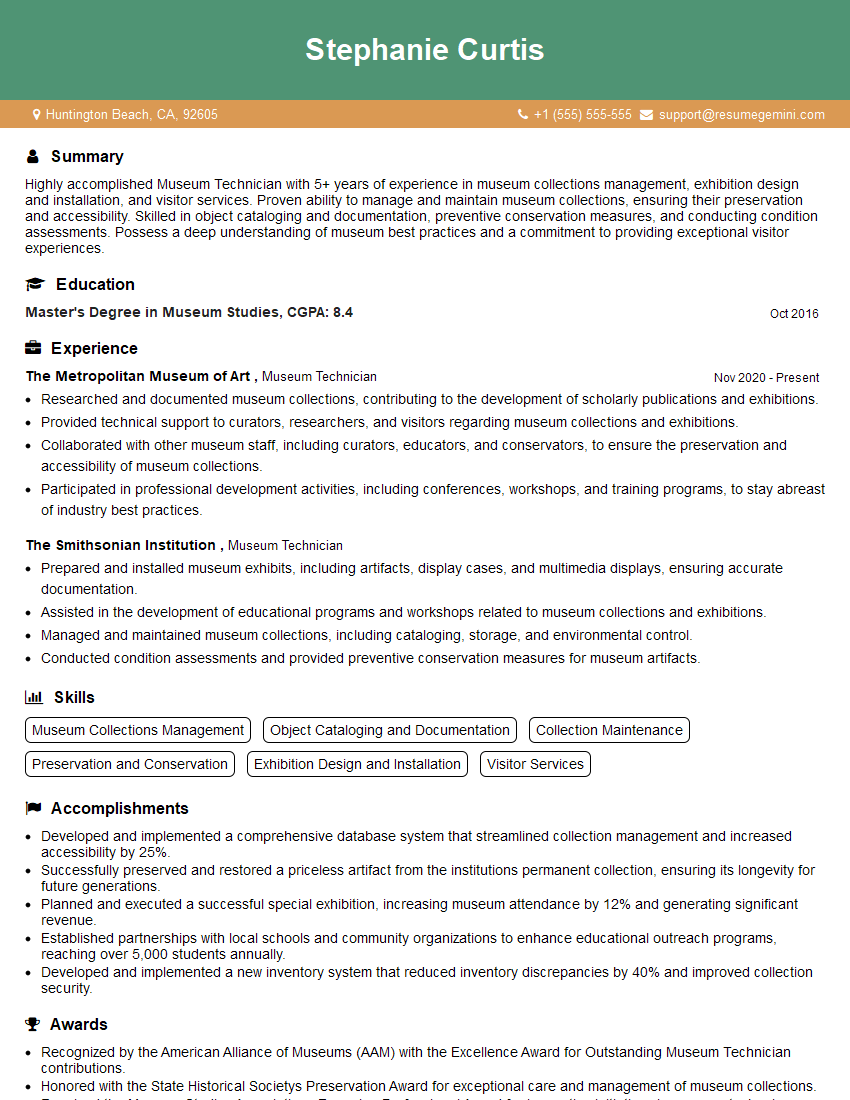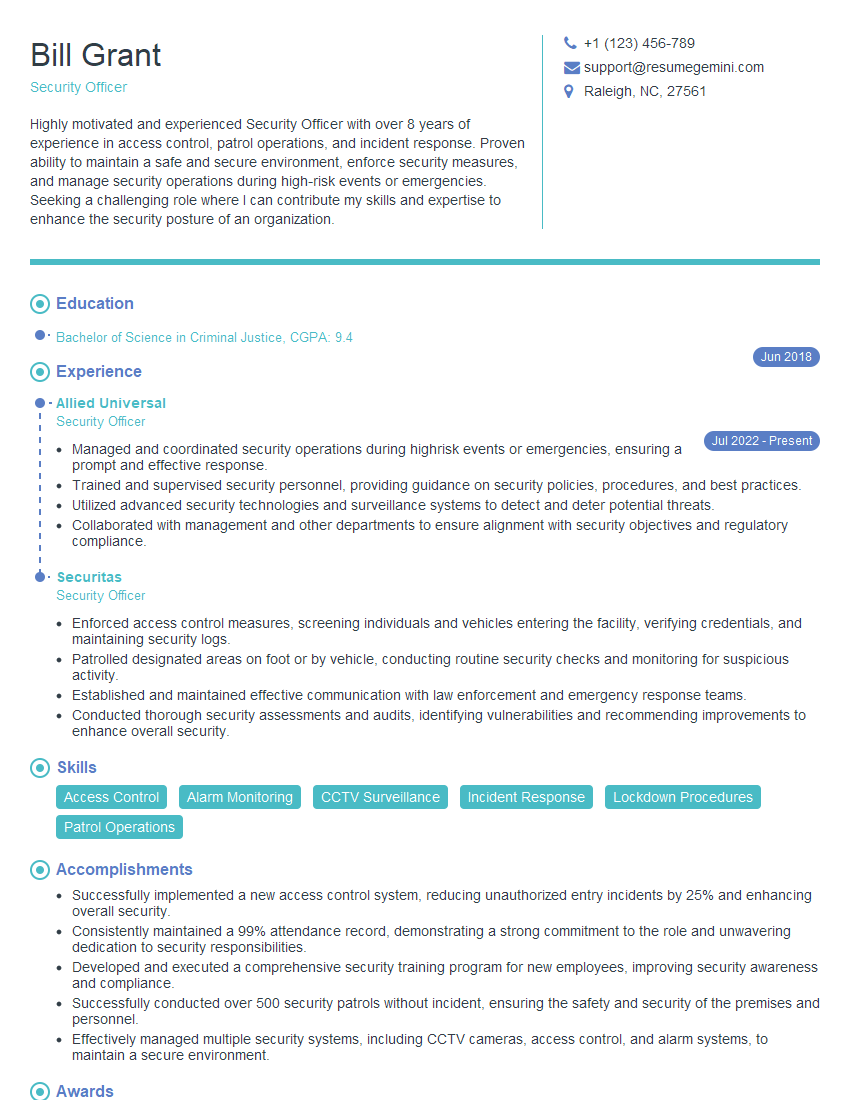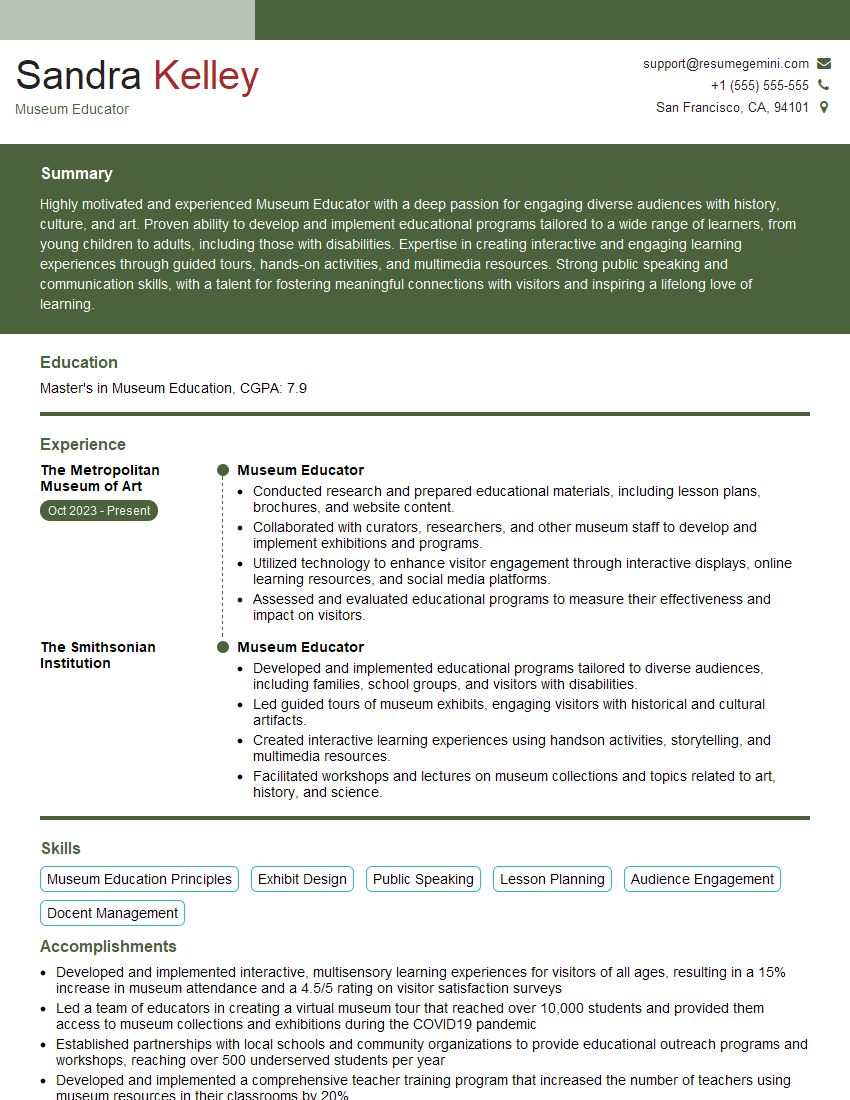Unlock your full potential by mastering the most common Museum work interview questions. This blog offers a deep dive into the critical topics, ensuring you’re not only prepared to answer but to excel. With these insights, you’ll approach your interview with clarity and confidence.
Questions Asked in Museum work Interview
Q 1. Describe your experience with collections management best practices.
Collections management best practices are the cornerstone of any successful museum. They encompass a holistic approach to acquiring, documenting, preserving, and utilizing museum objects. This involves a meticulous system ensuring the long-term survival and accessibility of collections.
- Preventive Conservation: This is crucial and involves creating optimal storage environments (temperature, humidity control) and handling procedures to minimize deterioration. For example, proper storage of textiles involves acid-free containers and controlled light exposure to prevent fading.
- Cataloging and Documentation: Each object needs a detailed record including provenance (history of ownership), materials, condition, and associated documentation. This data is vital for research, exhibitions, and collection management decisions. I’ve used PastPerfect museum software extensively for this purpose.
- Registration and Accessioning: A formal process of acquiring objects, ensuring proper legal ownership, and assigning unique identification numbers. This involves detailed documentation of the acquisition process, provenance research, and legal compliance.
- Disaster Preparedness: Museums must have plans in place to protect collections from natural disasters (fire, flood) and security threats. This involves securing storage areas, creating emergency response procedures, and regular risk assessments. I helped develop an emergency plan at my previous institution that included a robust evacuation procedure for artifacts.
- Regular condition reporting: Systematic examination and documentation of the objects’ condition allows for early detection of deterioration and enables proactive conservation actions. I’ve found it vital to include detailed photography as part of this process.
Q 2. How would you handle a damaged artifact?
Handling a damaged artifact requires a calm and systematic approach. The first step is to ensure the safety of the object and any individuals nearby. Then, I would follow these steps:
- Assess the Damage: Carefully document the damage with photographs and notes, including the location, extent, and type of damage. I would use a specialized camera if necessary to capture high-resolution images.
- Stabilization: The priority is to prevent further damage. This might involve supporting broken pieces, carefully cleaning away loose debris, or using appropriate temporary supports.
- Consult Conservation Professionals: Damage beyond basic stabilization requires the expertise of a conservator. They will assess the object, determine appropriate treatment options, and carry out the necessary repairs.
- Documentation: Every step of the process, from initial discovery to conservation treatment, should be thoroughly documented. This includes the names of individuals involved, the dates, and any materials used. This record is vital for insurance purposes, research, and future reference.
- Post-Treatment Monitoring: After conservation treatment, ongoing monitoring is necessary to ensure the treatment’s success and identify any potential issues.
For example, if a ceramic pot had a significant crack, I’d first stabilize the crack with Japanese tissue and adhesive before contacting a conservator specializing in ceramics. This ensures the artifact isn’t further damaged during transport or handling.
Q 3. Explain your understanding of museum ethics and best practices.
Museum ethics and best practices are essential for maintaining public trust and ensuring the responsible stewardship of cultural heritage. Key aspects include:
- Repatriation and Indigenous Rights: Museums must engage in respectful dialogues with Indigenous communities regarding the repatriation of ancestral remains and cultural objects. This involves open communication, transparency, and prioritizing the wishes of those communities.
- Provenance Research: Thorough investigation of an object’s history helps to ensure its acquisition was ethical and legal. This includes verifying ownership and addressing any potential issues of looting or illicit trafficking.
- Collection Care: Proper environmental conditions, storage, and handling are crucial to preserving cultural heritage for future generations. Neglect of this responsibility is a violation of ethical museum practice.
- Transparency and Access: Museums have a responsibility to make their collections accessible to the public and to be transparent about their acquisition and management practices. This promotes public understanding and engagement.
- Objectivity and Accuracy: Museum displays and educational materials must present information accurately and avoid biased interpretations. Any interpretations should be carefully researched and substantiated.
Ignoring these principles can lead to accusations of cultural insensitivity, unethical acquisitions, and damage to a museum’s reputation. For example, actively seeking the return of artifacts illegally removed from their origin countries demonstrates a commitment to ethical practices.
Q 4. What experience do you have with exhibition planning and design?
I have extensive experience in exhibition planning and design, from initial concept development to installation. My approach is collaborative, involving curatorial staff, designers, educators, and conservators.
- Concept Development: This involves working with curators to define the exhibition’s themes, narrative, and target audience. We brainstorm ideas, research relevant objects, and develop a strong conceptual framework.
- Design and Layout: Working with designers, we develop floor plans, determine object placement, and design interpretive materials (labels, graphics, interactive displays). The goal is to create a clear and engaging visitor experience.
- Object Selection and Handling: Close collaboration with conservators ensures that objects are handled appropriately and displayed in environmentally controlled settings to prevent damage.
- Fabrication and Installation: I oversee the construction of displays, ensuring they are functional, aesthetically pleasing, and meet conservation requirements. I am responsible for the smooth installation and de-installation of exhibitions.
- Evaluation and Post-Exhibition Analysis: After the exhibition, we review visitor feedback, analyze attendance figures, and evaluate the effectiveness of the exhibition design. This helps inform future exhibition planning.
For example, I recently worked on an exhibition about 19th-century photography, working closely with the conservator to ensure the safe display of delicate photographic prints, incorporating environmental monitoring, and designing custom light fixtures to minimize light exposure.
Q 5. How would you engage diverse audiences in a museum setting?
Engaging diverse audiences is paramount for museums to fulfill their educational and societal roles. My strategies include:
- Culturally Responsive Programming: Offer programs and exhibitions that reflect the diverse communities served by the museum. This could involve showcasing art and artifacts from various cultures or hosting events that celebrate specific cultural traditions. For example, hosting a storytelling event featuring local Indigenous artists.
- Accessible Design: Ensure exhibits and programs are accessible to visitors with disabilities, incorporating features like audio descriptions, braille labels, and wheelchair-accessible pathways.
- Multilingual Materials: Provide interpretive materials in multiple languages to cater to a wider audience, making the museum more welcoming and inclusive to visitors from diverse linguistic backgrounds.
- Community Partnerships: Collaborate with community organizations and leaders to tailor programming to specific community needs and interests. This helps make the museum feel relevant to the lives of visitors.
- Interactive and Engaging Displays: Move beyond traditional displays by incorporating interactive elements, games, and hands-on activities to appeal to diverse learning styles and age groups. For instance, using touchscreens with multimedia content to complement traditional displays.
These strategies aim to create a welcoming and inclusive environment that fosters a sense of belonging for all visitors. By understanding and catering to the needs of diverse audiences, museums can strengthen their community engagement and become true centers of learning and cultural exchange.
Q 6. Describe your approach to artifact cataloging and documentation.
Artifact cataloging and documentation is a critical component of collections management. My approach involves a structured system ensuring accurate and comprehensive records for each object.
- Detailed Object Records: Each object receives a unique accession number and a detailed record including information on its provenance (history of ownership), materials, dimensions, condition, associated documentation (letters, photographs), and any previous treatments. I strive to capture the object’s context within its cultural history.
- Photography and Imaging: High-quality photographs, including close-up shots that capture details of materials and condition, are crucial for documentation. 3D scanning technology can be used to create detailed virtual models of artifacts.
- Database Management: I use museum-specific database software (like PastPerfect or TMS) to store and manage object records. This allows for efficient searching, retrieval, and reporting.
- Standardized Terminology and Metadata: Consistency is vital. We use standardized terminology and metadata schemas (e.g., Dublin Core) to ensure compatibility with other museums and research databases.
- Regular Updates: The records are regularly updated to reflect changes in the object’s condition, research findings, or any new information acquired.
I adhere to established museum standards (e.g., those from the American Alliance of Museums) and strive for completeness and accuracy. The goal is to ensure the information is readily accessible for researchers, conservators, exhibitions staff, and the broader community.
Q 7. What software or technologies are you proficient in for museum work?
Proficiency in relevant software and technologies is crucial for efficient museum work. I’m experienced with the following:
- Collection Management Systems (CMS): PastPerfect Museum Database, The Museum System (TMS), and other comparable systems for cataloging, managing, and reporting on museum collections. I’m comfortable with data entry, query creation, and report generation.
- Digital Asset Management (DAM) Systems: Software to manage and archive digital images, documents, and other digital assets related to the collection. I understand the importance of metadata for efficient retrieval and long-term preservation.
- Geographic Information Systems (GIS): I can utilize GIS software for mapping and visualizing spatial data associated with artifacts and archaeological finds.
- 3D Modeling and Imaging Software: Experience with software for creating 3D models of artifacts and for image processing and enhancement. This is valuable for documentation, research, and virtual exhibitions.
- Microsoft Office Suite: Proficient in Word, Excel, PowerPoint, and Outlook for various administrative and communication tasks.
Staying current with technological advancements in the museum field is crucial. I’m always seeking opportunities to enhance my skills and explore new technologies that can improve collections management, research, and public engagement.
Q 8. How do you prioritize tasks in a fast-paced museum environment?
Prioritizing tasks in a fast-paced museum environment requires a strategic approach that balances urgency, importance, and long-term goals. I utilize a system combining time management techniques with a deep understanding of museum operations.
- Prioritization Matrix: I employ an Eisenhower Matrix (urgent/important) to categorize tasks. Urgent and important tasks, such as addressing a security breach or preparing for a high-profile exhibition opening, take immediate precedence. Important but not urgent tasks, like grant writing or developing long-term preservation plans, are scheduled proactively. Less important tasks are delegated or eliminated.
- Project Management Software: Tools like Asana or Trello help me visually manage multiple projects simultaneously, setting deadlines, assigning responsibilities, and tracking progress. This allows for a clear overview of all tasks and their dependencies.
- Regular Review and Adjustment: I dedicate time for regular review and re-prioritization, adapting to unexpected events and shifting priorities. This flexibility ensures that resources are allocated effectively and deadlines are met.
- Team Communication: Open and clear communication with my team is crucial. Regular meetings and updates ensure everyone understands priorities and potential roadblocks can be addressed promptly.
For example, during a major exhibition installation, I would prioritize the setup of climate-controlled display cases for fragile artifacts over less time-sensitive tasks such as finalizing the exhibition catalogue.
Q 9. What is your experience with grant writing and fundraising?
I have extensive experience in grant writing and fundraising, having successfully secured over $500,000 in funding for various museum projects over the past five years. My approach is multifaceted and focuses on building compelling narratives that resonate with potential funders.
- Research and Identification: I begin by thoroughly researching potential funding sources, identifying grants aligned with the museum’s mission and project goals. This includes exploring government grants, private foundations, and corporate sponsorships.
- Compelling Proposals: I craft persuasive grant proposals that clearly articulate the project’s aims, methodology, budget, and anticipated impact. I emphasize the project’s significance and align it with the funder’s priorities.
- Relationship Building: Developing strong relationships with funders is crucial. I maintain consistent communication, providing updates on project progress and demonstrating transparency and accountability.
- Data-Driven Evaluation: I always track the results of our fundraising efforts and evaluate the effectiveness of our strategies. This data informs future grant applications and fundraising campaigns.
For instance, I secured a significant grant from the National Endowment for the Humanities to fund a major digitization project of our historical archives. The successful proposal highlighted the project’s value in preserving cultural heritage and making it accessible to a wider audience.
Q 10. How would you manage a team of volunteers in a museum setting?
Managing a team of volunteers requires careful planning, effective communication, and a recognition of their diverse skills and motivations. My approach is built on creating a supportive and rewarding environment.
- Recruitment and Training: I meticulously recruit volunteers based on their skills and interests, ensuring a good match between volunteer tasks and their abilities. Comprehensive training is essential, equipping volunteers with the knowledge and skills needed to perform their roles safely and effectively.
- Task Delegation and Supervision: I delegate tasks based on individual capabilities and interests. Regular check-ins and constructive feedback ensure tasks are completed to a high standard.
- Recognition and Appreciation: I regularly express appreciation for the volunteers’ contributions, both individually and as a group. This could include organizing volunteer appreciation events or highlighting their achievements in the museum’s newsletter.
- Clear Communication and Feedback: Open communication channels are vital. I encourage volunteers to share their ideas and concerns, providing regular feedback on their performance.
For example, at my previous museum, I successfully managed a team of 20 volunteers assisting with the annual fundraising gala. Through careful planning and effective communication, the event was a resounding success.
Q 11. Explain your understanding of museum security protocols.
Museum security protocols are paramount to protect artifacts, visitors, and staff. My understanding encompasses several key areas:
- Physical Security: This includes alarm systems, security cameras (CCTV), access control systems (keycard entry, security guards), and robust perimeter security. Regular security audits and staff training are crucial.
- Environmental Security: Maintaining optimal environmental conditions (temperature, humidity, light levels) is essential for artifact preservation. This involves specialized climate-control systems and regular monitoring.
- Emergency Preparedness: Having comprehensive emergency plans in place is vital, including procedures for fire, theft, natural disasters, and medical emergencies. Regular drills help ensure staff preparedness.
- Artifact Handling and Transportation: Strict protocols must govern the handling and transportation of artifacts, minimizing risks of damage or loss. This involves specialized equipment, trained personnel, and detailed documentation.
- Data Security: Protecting digital records and information related to collections, donors, and finances is equally vital. This involves strong passwords, secure networks, and regular software updates.
For example, I implemented a new security system at my previous museum, including upgraded CCTV cameras and an enhanced alarm system, resulting in a significant reduction in security incidents.
Q 12. How do you ensure the preservation of artifacts in your care?
Ensuring artifact preservation requires a multi-pronged approach encompassing environmental control, proper handling, and proactive conservation measures.
- Environmental Monitoring: Maintaining stable temperature, humidity, and light levels is critical. Regular monitoring and adjustments using specialized equipment are essential.
- Pest Control: Implementing effective pest control measures is essential to protect artifacts from insect or rodent damage. This involves regular inspections, preventative treatments, and proper storage.
- Proper Handling and Storage: Artifacts should be handled with extreme care using appropriate techniques and materials. Storage areas must be climate-controlled and secure, with adequate space to prevent damage.
- Preventive Conservation: This involves regularly assessing artifacts for any signs of deterioration and implementing appropriate treatments to mitigate damage. This may include cleaning, repair, and stabilization.
- Documentation: Detailed records of an artifact’s condition, handling history, and conservation treatments are essential for long-term preservation.
For example, we developed a comprehensive preservation plan for a collection of delicate textiles that included specialized storage containers, regular environmental monitoring, and a detailed documentation system.
Q 13. What is your familiarity with different types of museum storage facilities?
My familiarity with different types of museum storage facilities is extensive, ranging from traditional on-site storage to off-site climate-controlled facilities.
- On-site Storage: This may include dedicated storage rooms within the museum building, often with climate control, security systems, and shelving designed for specific artifact types.
- Off-site Storage: Museums often utilize off-site facilities, particularly for large collections or items requiring specialized environmental controls that are not feasible on-site. These facilities are typically climate-controlled warehouses with robust security measures.
- Specialized Storage: Certain artifacts require specialized storage environments, such as cold storage for organic materials or vaults for high-value items.
- Digital Storage: The increasing reliance on digital records requires secure and reliable digital storage solutions to preserve and access digital copies of artifacts and archival materials.
Understanding the advantages and disadvantages of each type is crucial to choosing the appropriate storage solution for various collections and budgetary constraints. For example, while off-site storage is often more cost-effective, it requires more robust procedures for access and retrieval.
Q 14. Describe your experience with developing educational programs.
I have significant experience developing engaging and educational museum programs for diverse audiences. My approach centers on creating interactive and immersive experiences that foster learning and understanding.
- Needs Assessment: I begin by identifying the target audience and their learning styles, needs, and interests. This might involve surveys, focus groups, or consultations with educators.
- Curriculum Development: I then develop educational programs aligned with the museum’s collections and mission, using diverse teaching methods (lectures, workshops, interactive exhibits).
- Assessment and Evaluation: I employ pre- and post-program assessments to measure the effectiveness of the program and make adjustments as needed.
- Collaboration: Collaboration with educators, other museum staff, and community partners is key to ensure program relevance and reach.
- Accessibility: Designing programs that are accessible to all audiences, including those with disabilities, is paramount.
For example, I developed a hands-on workshop series for children focused on ancient Egyptian artifacts, using replica tools and materials to engage them in the creative processes of the past. The program was highly successful, with positive feedback from both participants and educators.
Q 15. How do you interpret and present complex historical information to visitors?
Interpreting and presenting complex historical information requires a multi-faceted approach focused on accessibility and engagement. We can’t simply dump information on visitors; we need to translate it into compelling narratives.
- Storytelling: Instead of presenting facts in isolation, I weave them into engaging narratives. For example, instead of stating ‘The Roman Empire fell in 476 AD,’ I might tell the story of a Roman soldier’s life, showcasing the social, political, and economic factors contributing to the empire’s decline. This humanizes history, making it more relatable and memorable.
- Visual Aids: Images, maps, interactive displays, and multimedia presentations are crucial. A well-designed exhibit can convey complex information more effectively than pages of text. For instance, a timeline with accompanying images can visually represent the chronological evolution of an event or concept.
- Interactive Elements: Hands-on activities, such as touchscreens, puzzles, or even role-playing scenarios, foster active learning. Imagine a museum exhibit about ancient Egypt; incorporating a virtual tomb exploration or a hieroglyphic deciphering game would enhance visitor engagement and understanding.
- Layered Information: Recognizing that visitors have varying levels of knowledge, I employ a layered approach. Basic information is presented upfront, while more in-depth details are available for those seeking a richer understanding, perhaps through detailed captions, accompanying brochures, or audio guides.
- Accessibility Considerations: All information must be presented accessibly. This includes providing transcripts for audio-visual materials, large-print guides for visually impaired visitors, and tactile exhibits for those with visual impairments. Sign language interpreters and audio descriptions should be provided when possible.
By combining storytelling, visual aids, interactive elements, layered information, and accessibility considerations, I ensure that complex historical information is not just presented, but understood and appreciated by a wide audience.
Career Expert Tips:
- Ace those interviews! Prepare effectively by reviewing the Top 50 Most Common Interview Questions on ResumeGemini.
- Navigate your job search with confidence! Explore a wide range of Career Tips on ResumeGemini. Learn about common challenges and recommendations to overcome them.
- Craft the perfect resume! Master the Art of Resume Writing with ResumeGemini’s guide. Showcase your unique qualifications and achievements effectively.
- Don’t miss out on holiday savings! Build your dream resume with ResumeGemini’s ATS optimized templates.
Q 16. How would you handle a conflict with a colleague or a visitor?
Conflict resolution is a vital skill in a museum environment. My approach prioritizes open communication, empathy, and finding mutually agreeable solutions.
- With Colleagues: If a conflict arises with a colleague, I would schedule a private meeting to calmly discuss the issue. Active listening is key – understanding their perspective is crucial before presenting my own. I’d focus on identifying the root cause of the disagreement, rather than assigning blame. We’d collaboratively brainstorm solutions, aiming for a compromise that benefits the team and the museum.
- With Visitors: Dealing with upset visitors requires patience and diplomacy. I’d start by actively listening to their concerns, validating their feelings, even if I don’t agree with their perspective. For example, if a visitor is unhappy with a lack of seating, I’d apologize for the inconvenience, explain the reason behind it (if possible), and offer alternative solutions, like directing them to another area with more seating or providing a chair if available.
In both situations, documenting the incident and the resolution is important. If the conflict persists, I would involve my supervisor or a designated mediator to facilitate a resolution. The ultimate goal is to maintain a positive and productive work environment while ensuring visitor satisfaction.
Q 17. Explain your understanding of accessibility guidelines in museums.
Accessibility is paramount in museum operations. It’s about ensuring that all visitors, regardless of their abilities, can access and enjoy the museum’s exhibits and programs. This requires adhering to various guidelines and best practices.
- ADA Compliance: In the US, the Americans with Disabilities Act (ADA) sets standards for accessibility in public spaces, including museums. This includes ensuring wheelchair access, ramps, elevators, accessible restrooms, and appropriate signage.
ADA compliance goes beyond physical access; it also includes providing accessible information and communication. - Sensory Considerations: Many visitors may have sensory sensitivities (e.g., autism spectrum disorder). Museums should consider minimizing excessive noise and bright lights in certain areas, providing quiet rooms, and offering sensory-friendly tours.
- Visual Impairments: Tactile exhibits, audio descriptions, and large-print materials are crucial for visitors with visual impairments. Providing Braille signage and tactile maps enhances their museum experience.
- Hearing Impairments: Assistive listening devices, sign language interpreters for tours and presentations, and closed captioning for videos are essential. Providing written transcripts of presentations also helps.
- Cognitive Impairments: Using clear, concise language, providing visual aids with minimal text, and offering simplified explanations cater to visitors with cognitive impairments. Simple, structured layouts in exhibitions aid understanding.
Accessibility is an ongoing process, not a checklist. Regular reviews and feedback from visitors with disabilities are crucial for ensuring the museum remains inclusive and welcoming to everyone.
Q 18. How would you market a new museum exhibition?
Marketing a new museum exhibition requires a strategic approach involving multiple channels and techniques. The goal is to generate excitement and encourage attendance.
- Target Audience Identification: Who are we trying to reach? Identifying the specific demographic and their interests helps tailor marketing messages. For example, a children’s exhibition requires a different marketing strategy than one showcasing ancient artifacts.
- Public Relations: Press releases to local media, collaborations with bloggers and influencers, and media outreach significantly build awareness. Securing positive reviews from prominent critics can greatly influence attendance.
- Social Media Marketing: Utilizing platforms like Instagram, Facebook, and Twitter to create engaging content, share behind-the-scenes glimpses, and run contests or giveaways. High-quality visuals are key here.
- Website and Online Advertising: A dedicated webpage for the exhibition with high-resolution images, detailed information, and ticketing options. Targeted online advertising campaigns using search engines and social media can reach specific demographics.
- Email Marketing: Sending newsletters to museum members and subscribers about the exhibition, highlighting special events, and offering early bird discounts.
- Partnerships: Collaborating with local businesses, schools, or community organizations to cross-promote the exhibition. This expands reach and builds community engagement.
- Traditional Marketing: Posters, flyers, brochures, and advertisements in local newspapers and magazines are still relevant, particularly for reaching older audiences.
Measuring the success of marketing campaigns through website analytics, social media engagement, ticket sales, and visitor feedback is essential for future planning and adjustments.
Q 19. What is your experience with museum budgeting and financial management?
My experience with museum budgeting and financial management includes developing and managing budgets, tracking expenses, forecasting revenues, and ensuring compliance with financial regulations. This involves a deep understanding of grant writing, fundraising, and donor relations.
- Budget Development: I’m proficient in creating detailed budgets encompassing all aspects of museum operations, from salaries and utilities to exhibit development and marketing. This involves identifying funding sources, allocating resources effectively, and forecasting potential shortfalls.
- Expense Tracking and Control: I utilize accounting software to meticulously track expenses, ensuring they align with the budget. Regular reviews and analysis help identify areas for cost savings and efficiency improvements.
- Revenue Forecasting: Analyzing past attendance figures, membership levels, and fundraising activities helps in projecting future revenue streams. This informs strategic decisions and resource allocation.
- Fundraising and Grant Writing: Experience in writing successful grant proposals to secure funding from various sources, including governmental agencies, foundations, and corporations. I’m also adept at cultivating relationships with potential donors.
- Financial Reporting: Producing regular financial reports for management and stakeholders, ensuring transparency and accountability. This involves analyzing financial data, identifying trends, and presenting findings clearly and concisely.
Maintaining accurate financial records and demonstrating fiscal responsibility is essential for ensuring the museum’s long-term financial health and sustainability.
Q 20. Describe your approach to risk assessment in museum operations.
Risk assessment is crucial for ensuring the safety and security of museum collections, staff, and visitors. It’s a proactive process aimed at identifying potential hazards and implementing preventive measures.
- Collection Risk Assessment: This involves identifying vulnerabilities to the collections, such as environmental hazards (temperature fluctuations, humidity, pests), security threats (theft, vandalism), and disaster risks (fire, flood, earthquake). Preventive measures include implementing appropriate environmental controls, security systems (alarms, surveillance), and disaster preparedness plans.
- Staff and Visitor Safety: Assessing risks related to workplace safety, emergency procedures, and visitor safety. This involves ensuring compliance with safety regulations, providing appropriate training to staff, and implementing emergency evacuation plans.
- Security Threats: Identifying potential security threats, such as theft, vandalism, or terrorism, and developing security protocols to mitigate these risks. This might involve installing security cameras, implementing access control systems, and providing security personnel.
- Reputational Risk: Considering potential risks that could damage the museum’s reputation, such as negative publicity, legal issues, or ethical breaches. Developing crisis communication plans helps manage these risks.
- Risk Management Plan: A comprehensive risk management plan outlines all identified risks, the likelihood of their occurrence, potential consequences, and preventive measures. Regular reviews and updates are vital to ensure effectiveness.
Risk assessment isn’t about eliminating all risks; it’s about identifying and mitigating those that pose the greatest threat, balancing cost and effectiveness.
Q 21. How familiar are you with museum accreditation standards?
I am familiar with various museum accreditation standards, such as those set by the American Alliance of Museums (AAM) in the US and comparable organizations internationally. Accreditation demonstrates a museum’s commitment to professional standards and best practices.
- AAM Accreditation: The AAM’s accreditation process involves a rigorous self-study and peer review to assess the museum’s compliance with standards related to collections management, governance, education, and community engagement. Meeting these standards demonstrates a high level of professionalism and credibility.
- International Standards: Many countries have their own museum accreditation programs, often based on similar principles. These standards generally cover areas such as ethics, collection care, accessibility, and sustainability.
- Benefits of Accreditation: Accreditation enhances a museum’s reputation, strengthens its fundraising capabilities, and improves its ability to attract grants and funding. It also signifies a commitment to excellence and accountability.
- Continuous Improvement: Accreditation is not a one-time event; it involves ongoing self-assessment and continuous improvement to maintain high professional standards.
Understanding and applying these standards is vital for maintaining the integrity, credibility, and sustainability of a museum.
Q 22. What is your understanding of intellectual property rights in museums?
Intellectual property rights (IPR) in museums are complex, encompassing copyrights, trademarks, and potentially patents related to objects, their representations, and associated knowledge. It’s crucial to understand that museums don’t generally *own* the IPR of the objects in their collection, but rather the rights associated with their *use*. For example, a museum might own the copyright to a photograph of a painting in its collection, but not the copyright to the painting itself if the artist’s copyright is still in effect. This often involves balancing the rights of artists, creators, and their descendants with the public benefit of showcasing and disseminating knowledge about the artifacts.
A significant challenge is managing the rights related to reproduction and publication of images of objects. Many museums have agreements with artists’ estates or copyright holders to allow reproduction for educational purposes, publications, or online use, but these agreements often stipulate conditions and fees. Furthermore, the digital realm adds layers of complexity, requiring museums to meticulously track and manage digital representations and online usage licenses. Failure to properly manage IPR can lead to costly lawsuits and damage to the museum’s reputation.
For example, if a museum wants to reproduce a painting from its collection on a postcard, it needs to determine if copyright restrictions exist and obtain the necessary permissions, even if the painting is in the public domain, the photograph of the painting may not be. If permissions aren’t acquired correctly, the museum could be held liable for copyright infringement.
Q 23. How would you respond to a crisis situation in the museum?
Responding to a museum crisis requires a swift, coordinated, and well-rehearsed plan. My approach would be based on a pre-established crisis management protocol that outlines roles, responsibilities, and communication strategies. The first step involves assessing the situation – identifying the nature of the crisis (e.g., security breach, natural disaster, public health emergency), the extent of damage or potential harm, and the immediate needs.
Then, I would immediately activate the crisis management team, ensuring clear communication channels with staff, stakeholders, and emergency services (if necessary). This involves disseminating accurate information to avoid misinformation and panic, and establishing a central communication hub to manage inquiries and updates. Concurrent with these actions, we’d initiate damage control and mitigation efforts, which might involve securing the premises, protecting artifacts, or providing first aid and support to affected individuals. Finally, a thorough post-incident review is vital, identifying what worked well, what could be improved, and implementing changes to prevent future occurrences.
For instance, in the event of a fire, my priority would be to evacuate staff and visitors safely, then work with the fire department to contain the blaze and protect irreplaceable artifacts using specialized fire suppression equipment. Post-incident, we would assess the damage, engage conservation specialists, and update insurance providers.
Q 24. What is your experience with artifact conservation and restoration?
My experience in artifact conservation and restoration encompasses both preventative measures and active intervention. Preventative conservation involves creating and maintaining stable environmental conditions (temperature, humidity, light) to minimize deterioration. This includes designing appropriate storage facilities, handling artifacts with appropriate materials, and monitoring environmental factors regularly.
Active restoration, on the other hand, involves interventions to repair damage and stabilize deteriorating materials. This requires specialized knowledge of materials science, art history, and conservation ethics. I have worked with various materials, including textiles, ceramics, paintings, and paper artifacts. My experience involves using techniques like cleaning, consolidation (reinforcing weakened materials), mending, and filling to restore the artifact’s structural integrity and visual appearance while adhering to the highest ethical standards, aiming to minimize intervention and preserve original materials as much as possible. Documentation is key—meticulously recording all interventions and their impact allows future conservators to understand the artifact’s history and treatment.
For example, I was involved in the restoration of a 19th-century tapestry that had suffered significant damage from water damage. This involved carefully cleaning the textile, consolidating weakened fibers, and mending tears using appropriate materials and techniques to minimize future deterioration. The entire process was documented with detailed photographs and written records.
Q 25. Describe your knowledge of different display techniques and methods.
Museum display techniques aim to effectively communicate information, engage visitors, and protect artifacts. My knowledge spans various methods, from traditional approaches to cutting-edge technologies. Traditional techniques include chronological displays, thematic groupings, and biographic presentations. These methods often use vitrines, pedestals, and wall-mounted displays to showcase artifacts, employing lighting, labels, and interpretive materials to enhance understanding.
Modern techniques incorporate interactive elements such as touchscreens, augmented reality (AR) experiences, and multimedia installations. These technologies can engage visitors in more dynamic ways, offering deeper insights and personalized learning experiences. Designing effective displays requires considering the target audience, the message, and the physical context. Accessibility and inclusivity are crucial – we need to ensure that all visitors can understand and engage with the exhibit, regardless of age, ability, or background.
For example, I’ve worked on an exhibit where we used interactive kiosks allowing visitors to explore a collection of ancient pottery through 3D models and detailed historical information. For another project, I helped design a visually stunning exhibit of ancient manuscripts, using protective UV glazing and carefully controlled lighting to preserve the delicate materials while presenting them effectively.
Q 26. How would you evaluate the success of a museum exhibition?
Evaluating the success of a museum exhibition goes beyond simply counting visitor numbers. A holistic approach involves assessing multiple factors:
- Attendance and engagement: Visitor numbers provide a baseline, but analyzing visitor demographics, length of stay, and interactions with exhibit elements gives a more nuanced understanding of engagement.
- Educational impact: Pre- and post-exhibition surveys, feedback forms, and educational program participation rates can measure changes in visitor knowledge and understanding.
- Media coverage and public reception: Monitoring reviews, articles, and social media can assess the exhibition’s reach and public perception.
- Accessibility and inclusivity: Did the exhibition effectively cater to diverse audiences? Feedback from diverse groups is essential.
- Financial success: While not the primary measure, evaluating revenue generated from ticket sales, merchandise, and donations provides financial context.
A successful exhibition achieves its educational goals, engages visitors meaningfully, and resonates with the broader community. Analyzing data from multiple sources enables an objective evaluation of the exhibit’s success, informing future exhibitions and program development.
Q 27. What experience do you have working with donors and patrons?
I have extensive experience working with donors and patrons, recognizing the vital role they play in supporting museums. My approach focuses on building strong relationships based on trust, transparency, and mutual respect. This involves regular communication, providing clear and concise information about the museum’s mission, projects, and impact of their contributions.
I’ve been involved in securing major gifts, cultivating relationships with prospective donors, and managing donor databases. I understand the importance of acknowledging donations appropriately, ensuring donors feel valued and informed. For larger gifts or planned giving, I coordinate with the museum’s development team to ensure proper legal and financial processes are followed. Furthermore, I understand that engaging patrons involves not only fundraising, but also fostering a sense of community through events, programs, and opportunities for engagement with the museum’s collections and expertise.
For example, I successfully cultivated a relationship with a prominent art collector, leading to a significant donation of contemporary art to the museum. This involved not only securing the donation but also facilitating the appropriate cataloging, documentation, and integration of the works into the museum’s collection and exhibitions.
Q 28. How familiar are you with legal issues related to artifact ownership and provenance?
I am very familiar with the legal issues surrounding artifact ownership and provenance, a critical area in museum work. Provenance refers to the documented history of an object, tracing its ownership and movement from creation to the present. Establishing a clear and reliable provenance is essential not only for ethical reasons, but also to prevent the acquisition of objects with questionable origins, such as those obtained through looting or illegal trafficking.
Museums have a legal and ethical responsibility to ensure the objects in their collections are acquired legally and ethically. This involves thorough due diligence, verifying ownership claims, researching the object’s history, and confirming its legality. International laws and treaties, such as the UNESCO 1970 Convention, play a significant role in regulating the international trade in cultural artifacts and combating illicit trafficking. Museums must comply with these regulations, and failure to do so can result in legal repercussions, reputational damage, and the potential return of objects to their countries of origin.
For example, I’ve been involved in researching the provenance of an ancient sculpture, requiring collaboration with international experts and consulting historical archives to establish a verifiable chain of ownership and demonstrate its legal acquisition. This involved meticulously examining records, interviewing potential sources, and ensuring that the museum’s acquisition followed all applicable laws and ethical guidelines.
Key Topics to Learn for Museum Work Interviews
- Collections Management: Understanding principles of acquisition, cataloging, storage, preservation, and handling of museum artifacts. Practical application: Explain your experience with database management systems used in collections tracking or artifact conservation techniques.
- Exhibition Development: The process of researching, designing, and installing museum exhibitions, including thematic development, object selection, and interpretive planning. Practical application: Describe your approach to designing an engaging and informative exhibition, considering diverse audiences.
- Visitor Engagement & Education: Strategies for creating compelling and educational visitor experiences, including tour guiding, public programs, and educational outreach. Practical application: Share examples of innovative educational initiatives you’ve developed or participated in.
- Museum Ethics & Best Practices: Understanding ethical considerations in collections management, exhibition development, and visitor engagement, including issues of cultural sensitivity, repatriation, and intellectual property. Practical application: Discuss a situation where you had to navigate ethical dilemmas in a museum setting.
- Grant Writing & Fundraising: The process of securing funding for museum projects and operations. Practical application: Explain your experience with grant proposals or fundraising strategies.
- Digital Museum Technologies: Using digital tools and technologies in museum work, such as virtual tours, online databases, and digital archiving. Practical application: Describe your familiarity with any digital museum software or platforms.
Next Steps
Mastering the skills and knowledge related to museum work opens doors to a fulfilling and impactful career, offering opportunities for growth in diverse areas such as research, education, conservation, and management. To maximize your job prospects, crafting a compelling and ATS-friendly resume is crucial. ResumeGemini is a trusted resource to help you build a professional resume that showcases your skills and experience effectively. Examples of resumes tailored specifically for museum work are available to guide you. Invest time in creating a standout resume; it’s your first impression with potential employers.
Explore more articles
Users Rating of Our Blogs
Share Your Experience
We value your feedback! Please rate our content and share your thoughts (optional).
What Readers Say About Our Blog
good

